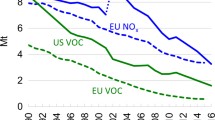Abstract
The growth in population (Fig. 1) plus the growth in energy consumption per person(1) have combined together to give dramatic increases in both air and water pollution problems. The automotive vehicle has been a significant contributor to air pollution on a total mass basis (Fig. 2), although its contribution is considerably smaller if the toxicity of emissions as well as the quantity of emissions is considered (Fig. 3).(2) Thus, the purpose of this paper is to first of all indicate why certain exhaust constituents from automotive vehicles are considered as pollutants, to describe how these pollutants are formed in automotive vehicle operation, and finally, to describe control techniques being used and considered. As indicated in the title, the paper is intended to educate by organizing and systematizing existing information rather than presenting primarily new information.



Access this chapter
Tax calculation will be finalised at checkout
Purchases are for personal use only
Preview
Unable to display preview. Download preview PDF.
Similar content being viewed by others
References
Myers, P.S., Automotive emissions—A study in environmental benefits versus technological costs, SAE Trans. Vol. 79, Paper 700182 (1970).
Barr, H.F., Automotive air pollution control, Paper 700248 presented at SAE Automotive Engineering Congress, Detroit, January 1970.
Barnes, G. J., Relation of lean combustion limits in diesel engines to exhaust odor intensity, SAE Trans. Vol. 77, Paper 680445 (1968).
Jackson, M.W., Wiese, W. M., and Wentworth, J.T., The influence of air-fuel ratio, spark timing and combustion chamber deposits on exhaust hydrocarbon emissions, published in TPS-6, Vehicle Emissions — Part I, Paper 486-A, Society of Automotive Engineers, Inc., New York.
National Academy of Engineering, Effects of Chronic Exposure to Low Levels of Carbon Monoxide on Human Health, Behavior, and Performance. Washington, D.C., 1969.
Myers, P.S., Spark Ignition Engines Combustion and Lead. Presented at Washington Academy of Sciences, January 21, 1971.
Newhall, H.K., Kinetics of engine generated nitrogen oxides and carbon monoxide, Twelfth Symposium (International) on Combustion, The Combustion Institute (1969), p. 603,
Huls, T.A., Myers, P.S., and Uyehara, O.A., Spark ignition engine operation and design for minimum exhaust emissions, published in PT-12, Vehicle Emissions—Part II, Paper 660405, Society of Automotive Engineers, Inc., New York, 1967.
Newhall, H.K., and Shahed, S.M., Kinetics of nitric oxide formation in high pressure flames, Paper 36 presented at Thirteenth Symposium (International) on Combustion, Salt Lake City, August 1970.
Shahed, S.M., and Newhall, H.K., Kinetics of nitric oxide formation on propane-air and hydrogen-air diluent flames, Combustion and Flame, 17, 2 (1971).
Campau, R.M., and Neurman, J.C., Continuous mass spectrometric determination of nitric oxide in automotive exhaust, SAE Trans., Vol. 75, Paper 660116 (1967).
Smith, D.S., et al., Oxides of nitrogen from gas turbines, J. Air Poll. Cont. Assoc. 18, 1 (1968).
Yumulu, V.S., and Carey, A.W., Exhaust emission characteristics of four-stroke, direct injection, compression ignition engines, Paper 680420 presented at SAE Mid-Year Meeting, Detroit, May 1968.
Landen, E.W., Nitrogen oxides and variables in precombustion chamber type diesel engines, Paper 714B presented at SAE Summer Meeting, Montreal, June 1963.
Daniel, W.A., Flame quenching at the walls of an internal combustion engine, Sixth Symposium on Combustion, Reinhold Publishing Co., 1957.
Daniel, W.A., Why engine variables affect exhaust hydrocarbon emission, SAE Trans., Vol. 79, Paper 700108 (1970).
Stivender, D.L., Intake valve throttling (ITV) — A sonic throttling intake valve engine, SAE Trans., Vol. 77, Paper 680339 (1968).
Bartholemew, E., Potentialities of vehicle emission reduction by design of induction systems, Paper 660190 presented at SAE Automotive Engineering Congress, Detroit, January 1966.
Street, J.C., and Thomas, A., Carbon formation in premixed flames, Fuel, 34, 4–36 (1955).
Porter, G., Carbon formation in the combustion wave, Fourth Symposium (International) on Combustion, p. 248 (1952).
Parker, W.G., and Wolfhard, H.G., Carbon formation in flames, J. Chem. Soc. pp. 2038–49 (1950).
Flynn, P., An experimental determination of instantaneous potential radiant heat transfer within an operating diesel engine, Ph. D. Thesis, 1971.
Trumpy, D., Sorenson, S.C., and Myers, P.S., Discussion of Ref. 3.
Maga, J.A., and Hass, G.C., The development of motor vehicle exhaust emission standards in California, Fifty-third Annual Meeting, APAC, Cincinnati, 1960.
Teague, D.M., Los Angles traffic pattern survey, Paper 171 presented at SAE National West Coast Meeting, Los Angles, August 1957.
Hass, G.C., and Brubacher, M.L., A test procedure for motor vehicle exhaust emission, J. Air Pol. Cont. Assoc. 12, 505 (1962).
Control of air pollution from new motor vehicles and new motor vehicle engines, Federal Register 33, 2 (1968).
Draft Regulation: Uniform Provisions Concerning the Approval of Vehicles Equipped with a Positive Ignition Engine With Regard to the Emissions of Gaseous Pollutants by the Engine. Economic Council for Europe, April 11, 1969.
Author information
Authors and Affiliations
Editor information
Editors and Affiliations
Rights and permissions
Copyright information
© 1973 Plenum Press New York
About this chapter
Cite this chapter
Myers, P.S., Uyehara, O.A., Newhall, H.K. (1973). Engine Exhaust Emissions. In: Springer, G.S., Patterson, D.J. (eds) Engine Emissions. Springer, Boston, MA. https://doi.org/10.1007/978-1-4684-1983-2_1
Download citation
DOI: https://doi.org/10.1007/978-1-4684-1983-2_1
Publisher Name: Springer, Boston, MA
Print ISBN: 978-1-4684-1985-6
Online ISBN: 978-1-4684-1983-2
eBook Packages: Springer Book Archive




